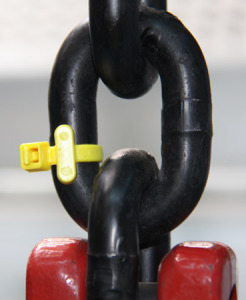The evolution of cable identification and wiring accessories
By John Banks, UK National Production Manager for identification at HellermannTyton
Using cable management solutions to identify wiring, long-running cables and components is vital. Clear identification aids future maintenance and reconfigurations, as well as providing reassurance to those responsible for health and safety. However, as the technology and methods of cable management and wiring accessories evolve it is important for installers to understand how and why they should use certain products and, most importantly, what developments are making the job of identification easier than ever before.
Identification has come a long way since we began manufacturing solutions. Markers that slide on to the label were applied one-by-one, with separate letters and numbers used to provide a readable label. Just like a bar code the marker held significant information, yet, although tried and tested for many years this solution has proven time-consuming, repetitive and can produce a potential risk if readability is compromised or the label misinterpreted.
One of the more important aspects is choosing the right material for each application and that such accessories and ID meet certain criteria. This will ensure that any labelling is protected and the risk of destroyed information is reduced by simply choosing the correct solution.
Multiple lines of text
A Thermal Identification Printing System, or TIPS to most, is the next step up from the simple slide on markers or adhesive labelling systems. Consisting of a thermal printer, ribbon and easy-to-use software, TIPS products make it possible to have multiple lines of text with images and even bar and QR codes, and with the accompanying software, creating data tables that consist of hundreds of automatically sequenced idents takes just seconds. This type of identification is trusted by the likes of Air Traffic Control, who rely on such a system to identify long runs of cabling that run under several rooms.
For those seeking to mark a variety of cable sizes and find an even simpler way to apply information, heat shrink tubing is an option to consider. Essentially printable sleevings, the tubing significantly reduces costs by eliminating the need to make up legends using individual cable markers and the tubing shrinks to fit around cables and wires to become a permanent marking. Once again, this ensures no tampering or removal and provides a safe way to avoid human error. An additional benefit of heat shrink tubing is its ability to work in extreme temperatures between -55°C up to +225°C, which again is ideal for arduous and unpredictable environments.
The biggest improvement in terms of identification software and accessories comes in the form of Radio Frequency Identification (RFID) technology, which provides larger capacity and productivity, working in sync with existing systems.
Intelligent, compact and ideal for use within all sectors, RFID data technology is being used within the industry to collate and register products that can talk to a network system – essentially it’s a tracker that can be read even when the labelling can’t. Similar to a bar code an RFID tag is a data carrier which holds pre-programmed information in a small computer chip and operates on a wide range of frequencies.
Opportunities for using RFID technology
This use of RFID within cable management means that not only can each cable be identified, but the tags can potentially be changed, updated and locked, with risk of damage and marks being accidentally removed greatly reduced. Although there is still a wider scope of opportunities for using RFID technology, it has provided the installer with a secure and reliable identification system. Benefits include taking away manual reading mistakes, the ability to pre-programme a serial number to provide a direct link to a network without human contact and compatiblility with existing systems.
RFID tags won’t entirely replace traditional identification methods such as printed labels and heat shrink tubing. However, as time goes on we will see more use for RFID, with an increased focus on seamless wireless installations and registration within cable and wire applications. Yet, no matter how much progress is made, technology will always be an additional complement and quality check to traditional methods and straightforward labelling solutions.
The best advice is to take all components into account when choosing solutions and apply to same diligence to cable management products as the larger elements. By selecting the right material and solution for each application, installers can be confident in their work, ensuring end-user risk is minimised and time on a project is being spent wisely.




